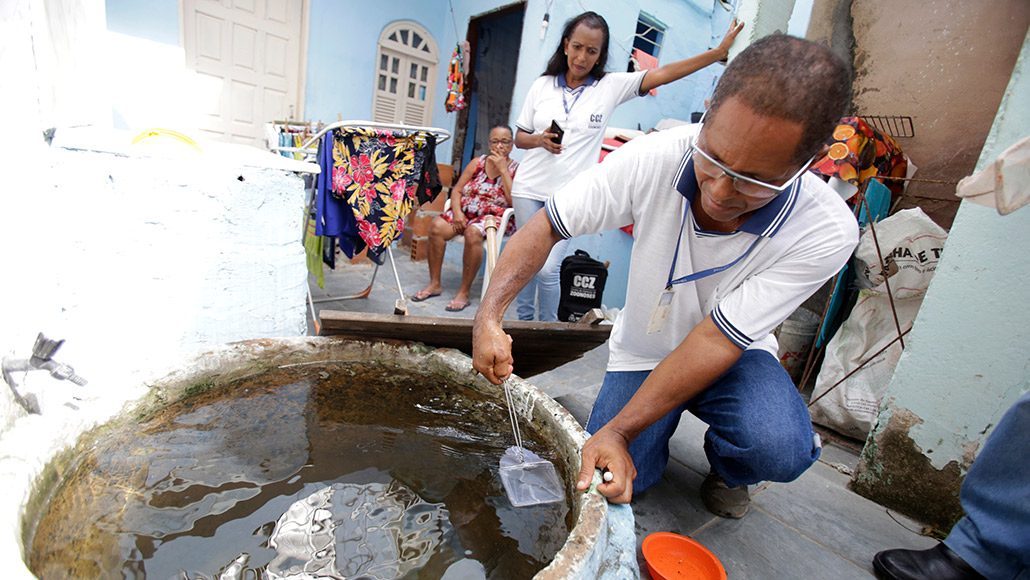Dengue cases in the Americas have reached an all-time high
Infections with the mosquito-borne virus are surging worldwide

A worker collects Aedes aegypti mosquito larva in Salvador, Brazil, in July. Ridding homes and neighborhoods of pools of standing water, where mosquitoes breed, can help to stop the spread of dengue.
Joa Souza/Shutterstock
- More than 2 years ago
The Americas set a gloomy record in 2019: the most dengue cases ever reported. More than 2.7 million cases of the mosquito-borne disease have struck the region, largely in Brazil, the Pan American Health Organization reported on November 13.
Dengue is one of the top 10 threats to global health, according to the World Health Organization, with cases of the viral disease climbing rapidly around the world in recent decades. An estimated 390 million dengue infections occur each year, which can be mild or cause flulike symptoms and headaches. Less commonly, dengue can lead to a severe, life-threatening illness. South Asian countries including Pakistan, Bangladesh and Nepal have also been slammed with large dengue outbreaks this year (SN: 10/7/19).
The last record-breaking year for the Americas was 2015, when there were more than 2.4 million cases. After that, cases dropped slightly in 2016 and then precipitously in 2017 and 2018, coming in below 600,000 each of those years. “Dengue is endemic in the Americas, with cycles of the epidemics that are repeated every three to five years,” says Jose Luis San Martin, an advisor on dengue and other mosquito-borne diseases for PAHO in Washington D.C. “During those two years there was an accumulation of a large number of people susceptible to the disease.”
That may seem like too short a time for so many people to be vulnerable again to dengue, transmitted by the bite of an Aedes aegypti mosquito. But dengue outbreaks are complicated by the fact that there are four different types of the virus. Infection with one type provokes the development of antibodies that provide lifelong immunity to that type. Those antibodies can initially protect against other types, but that effect is temporary, lasting roughly one to three years.
All four types of dengue are regularly found in the Americas, and all four have been circulating this year in Brazil, Mexico and Guatemala. Brazil has had the most cases in the Americas so far this year, with more than 2 million, followed by Mexico, where there are close to 214,000 cases.
A population’s susceptibility to dengue depends upon its past history of epidemics — which dengue viruses were circulating, and how intense the epidemics were. And cases don’t always hit the same places in a region with each epidemic, so the herd immunity — the threshold at which enough people are exposed that others who aren’t are still protected — varies depending on the area.
The Latin American Zika outbreak of 2015 to 2016 (SN: 10/30/17) may have impacted the region’s dengue cases in recent years, says Albert Ko, an infectious disease physician and epidemiologist at the Yale School of Public Health. In February, Ko and his colleagues reported that having dengue first may have protected some people from Zika in the northeast Brazilian city of Salvador (SN: 2/7/19). Perhaps that works the other way around as well, Ko says, noting that Salvador experienced a large decrease in cases of dengue after the Zika epidemic, which hit northeastern Brazil especially hard. It’s possible that the Zika epidemic “gave some protection, and now that’s wearing off.”
Ko has had dengue three times. “It’s not a pleasant thing,” he says. “It can be pretty debilitating for a period.” He had bad headaches and felt “washed out” afterwards.
Having all four types of dengue circulating can also lead to severe cases. If a person is infected with dengue type 1, for example, a subsequent infection with any other type can be much worse, because of a phenomenon called antibody dependent enhancement (SN: 11/8/17). There have been almost twice as many severe cases of dengue in the Americas so far in 2019 compared with 2015; 22,127 rather than 12,495. But there have also been fewer deaths, PAHO reports: 1,206 as of November 13, compared with 1,355 for all of 2015.







